The New Co‑Developer: AI’s Integration into the Web Development Lifecycle
AI is now a foundational layer of the modern stack. The conversation has shifted from if AI helps to how to leverage it for maximum impact. What began as autocomplete now functions as augmentation: AI participates in creative problem‑solving, architectural choices, and end‑to‑end workflow acceleration.
Signals of this shift are everywhere—broad developer adoption in industry surveys and analyst forecasts that AI will influence the majority of app design and development processes over the next few years. The practical takeaway: AI is essential for building dynamic, user‑centric web apps in 2026.
What this guide covers: a strategic map of the tools shaping modern web development, organized by SDLC phase and anchored in real team workflows.
Key Trends for 2026: Agentic, Multimodal, Integrated
1) The Rise of Agentic AI
We’re moving from single‑prompt helpers to agents that plan, modify multiple files, run tests, and iterate with minimal guidance. Early examples include Copilot’s Agent Mode and Cursor’s project‑wide Agent, plus specialized agents for testing, docs, and reviews.
2) Multimodal Development
Text is no longer the only interface. Sketch‑to‑UI (Uizard), prompt‑to‑layout (Framer AI), image‑guided asset generation (Midjourney), and voice‑driven workflows shrink the gap between idea and implementation.
3) The Human‑in‑the‑Loop Imperative
As autonomy grows, so does the need for expert oversight. Developers increasingly distrust “almost‑right” AI outputs. The winning pattern keeps humans as strategic directors and validators, with AI handling the heavy lifting inside clear guardrails.
Mapping AI Across the SDLC
To evaluate tools effectively, map them to your workflow. AI now spans every stage—from design to deployment. The goal isn’t picking a single winner; it’s architecting a cohesive AI toolchain. Standards like the Model Context Protocol (MCP) point toward interoperable, system‑level design.
| SDLC Phase | Key AI‑Powered Task | Leading Tools (2026) |
|---|---|---|
| Design & Prototyping | From sketch/prompt to UI | Uizard, Framer AI, Midjourney |
| Code Generation & Implementation | Context‑aware completion & agentic workflows | GitHub Copilot, Cursor, Tabnine, Amazon Q Developer |
| Testing & QA | Automated visual & functional regression | Applitools, Testsigma, Mabl |
| Security & Compliance | Real‑time vuln scanning & remediation | Snyk, Mend.io |
| Code Quality & Review | Behavioral analysis & automated refactors | CodeScene, DeepSource, Coderabbit |
| PM & Collaboration | AI sprint planning & risk assessment | Jira, Asana, Linear |
The Core Engine: AI Coding Assistants (Head‑to‑Head)
GitHub Copilot: The Ubiquitous Pair Programmer
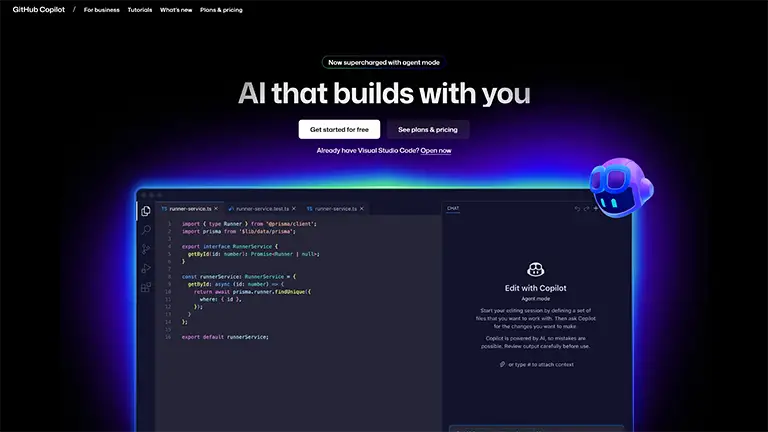
Why teams pick it: deep GitHub integration (IDE, PRs, Actions). Agent Mode tackles multi‑file edits, tests, and reviews; Copilot Chat explains code, proposes tests, and assists debugging. Broad language coverage and familiar dev ergonomics make it the default for many teams.
Pricing snapshot (2025): Free (limited), Pro for individuals, Business for org controls/IP indemnity, and Enterprise for GitHub‑native knowledge + policy controls.
Where it shines: speed, boilerplate, tests, and familiar patterns. Watch‑outs: still requires human review for edge cases, security, and complex cross‑repo tasks.
Tabnine: Enterprise‑Grade & Privacy‑Focused
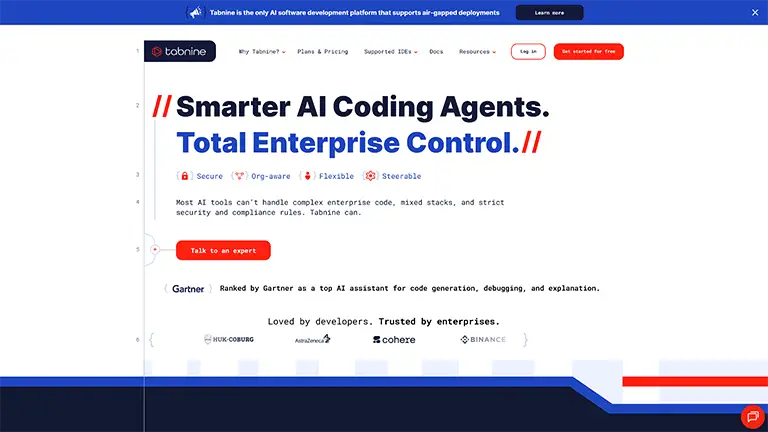
Why teams pick it: self‑hosting (on‑prem/VPC/air‑gapped) and models trained on your private repos for tailored suggestions and policy compliance.
Pricing snapshot: Dev and Enterprise tiers; enterprise unlocks private deployment, custom models, admin controls, and IP indemnity.
Where it shines: regulated industries and code ownership mandates. Watch‑outs: higher resource usage; best results when trained on your codebase.
Amazon Q Developer: Cloud‑Native Specialist (AWS)
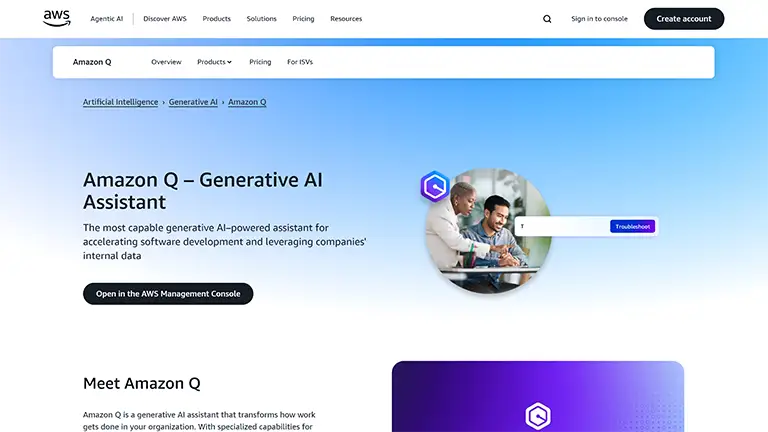
Why teams pick it: deep, service‑aware AWS expertise and Bedrock‑based multi‑model routing (e.g., Claude for reasoning, Titan for code). Works in IDEs, AWS Console, and CLI; excels at IAM policies, Lambda, CloudFormation/Terraform assistance.
Pricing snapshot: generous free tier plus Pro with enterprise controls and customization on your code.
Where it shines: AWS‑centric teams. Watch‑outs: less helpful off‑AWS and initial setup requires IAM savvy.
Cursor: The AI‑First Code Editor
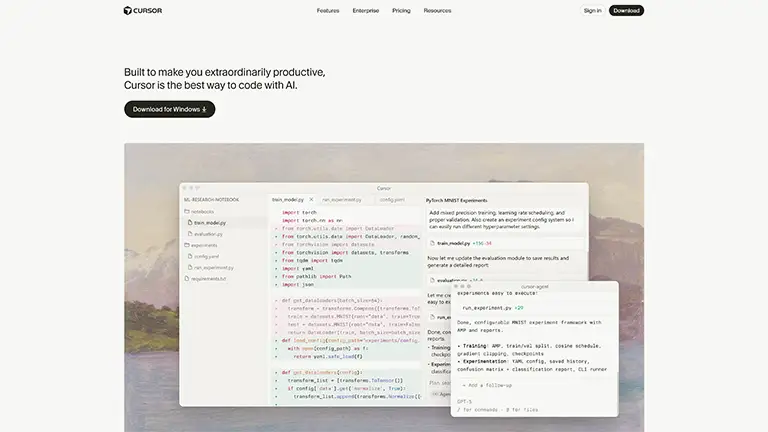
Why teams pick it: AI‑native IDE with a project‑wide Agent and multi‑model flexibility (OpenAI/Anthropic/Google). Forked from VS Code, so it feels familiar and supports VS Code extensions. Integrates via MCP with Figma/Linear/Slack.
Pricing snapshot: Free trial; Pro/Pro+/Ultra usage credit tiers; Teams with SSO and centralized billing.
Where it shines: complex multi‑file tasks and power users. Watch‑outs: UI can feel busy; usage‑based costs must be managed.
Quick Comparison
| Feature | GitHub Copilot | Tabnine | Amazon Q | Cursor |
| Differentiator | GitHub ecosystem depth | Private/self‑hosted models | AWS expertise + Bedrock routing | AI‑first IDE + multi‑model |
| Best for | GitHub‑centric teams | Regulated orgs & IP control | AWS‑heavy workloads | Power users & advanced workflows |
| Standout | Agent Mode, PR reviews | Custom models on your code | Service‑aware guidance | Codebase‑wide context |
| Limitation | Context limits cross‑repo | Resource‑intensive | Less helpful off‑AWS | Cost/UX management |
Bottom line: align the tool to your stack and philosophy: ecosystem integration (Copilot), security control (Tabnine), cloud specialization (Amazon Q), or model‑agnostic flexibility (Cursor).
From Ideation to Interface: AI for Design, Prototyping & Assets
Rapid Prototyping (Design‑to‑Code)
-
- Uizard: lightning‑fast ideation; turn sketches/screenshots into editable mockups. Best for MVP brainstorming, not pixel‑perfect delivery.
-
- Framer AI: prompt‑to‑layout wireframing and a powerful visual editor for interactive, production‑adjacent prototypes. Great hand‑off from Figma or publish simple sites directly.
Recommendation: Use Uizard to validate concepts quickly; move to Framer AI to polish interactions and page flows.
Generative Assets (Images, Icons, Motion)
-
- Midjourney for concept art, hero images, and style exploration (use aspect ratios like
--ar 16:9).
- Midjourney for concept art, hero images, and style exploration (use aspect ratios like
-
- DALL·E for precise UI illustrations/icons; conversational tweaks nail brand fit.
-
- Runway to add subtle motion to static assets for engaging hero sections without heavy video pipelines.
Caution: Avoid “vibe coding.” Beautiful mockups can mask technical debt. Treat AI visuals as a starting point; validate with UX principles and performance budgets.
Fortifying the Build: Testing, Security & Code Quality
Automated Testing & QA
-
- Applitools Visual AI reduces false positives vs. pixel diffs and plugs into Selenium/Cypress/Playwright.
-
- Testsigma / Mabl enable natural‑language tests and self‑healing selectors to lower maintenance.
-
- AI‑generated unit/integration tests lift coverage and catch logic errors early.
Proactive Security (DevSecOps)
-
- Snyk integrates SAST, SCA, and container scanning into IDE/CLI/CI for developer‑first fixes.
-
- Mend.io & Robust Intelligence harden LLM features: prompt defenses, AI red‑teaming, jailbreak/poison testing.
Intelligent Code Review
-
- CodeScene highlights behavioral hotspots (complex + frequently changed) to prioritize refactoring.
-
- DeepSource/Codacy identify issues and propose Autofix patches inside PRs to enforce standards.
Strategic Implementation: Make AI Work for Your Team
Prompting as a Core Skill
Be explicit about libraries, patterns, constraints, and acceptance tests. Provide code/context. Iterate: ask for explanations, alternatives, and targeted revisions.
Prompt template
You are a senior {framework} engineer. Implement {feature} inside {repo structure}. Use {library/pattern}. Add unit tests with {framework}. Follow {lint/security rules}. Optimize for {perf/SEO/a11y}. Constraints: {edge cases}. Output: patch diff + test results.The Critical Review Imperative
Treat AI output like code from a talented junior. Verify logic, security, performance, and accessibility. Pair human review with automated checks (tests, Snyk, linters, Lighthouse/PSI).
Team Integration Patterns
-
- Roles: Human Navigator, AI Driver.
-
- Guardrails: TDD, strong typing, explicit interfaces, architectural docs.
-
- Knowledge Transfer: Use AI to summarize legacy modules, generate onboarding guides, and scaffold examples.
Measuring ROI
Track cycle time, PR throughput/merge rates, escaped defects, and developer focus. Combine quantitative metrics with qualitative satisfaction.
The Horizon Beyond 2025
The Agentic Leap
Expect multi‑agent systems with planning, memory, and standardized integrations (MCP) that can deliver larger chunks of a feature autonomously.
The Evolving Role of Developers
Less time on syntax; more on product context, systems design, and orchestrating AI. Communication, security mindset, and architectural thinking become career multipliers.
Future‑Proofing Skills
Adopt AI daily, master prompting, invest in systems design, review/security discipline, and build real projects to internalize patterns.
Practical Stack: A Reference Implementation
Baseline IDE/Editor
-
- Cursor (Pro) or VS Code + Copilot Business
Security & Quality
-
- Snyk (IDE/CI), CodeQL or DeepSource, Prettier/ESLint, TypeScript strict
Testing
-
- Playwright (E2E + Visual via Applitools), Vitest/Jest, Testsigma for NL test authoring
Design & Content
-
- Figma → Framer AI for interactive prototypes; Midjourney/DALL·E for assets; Runway for subtle motion
Process
-
- Linear/Jira with AI planning, Conventional Commits, PR templates with checklists (tests, a11y, security)
Guardrails
-
- Performance budgets (LCP/INP), a11y gates (axe), dependency policies, CI policy checks
Best AI & Web Dev Tools for Beginners (2026)
Where this fits: Place this section right here, just before Conclusion, so newcomers encounter a simple starter stack after the “Practical Stack” reference and before wrap‑up.
New to web development? Start with these five tools. They’re easy to set up, free or low‑cost, and give you AI assistance, practice projects, and one‑click deploys so you see results fast.
1) GitHub Copilot Free (AI Pair Programmer)

Why beginners love it: Instant inline suggestions, chat for explanations, and small monthly limits that are plenty for learning.
Starter setup
-
- Install VS Code or Cursor → add the Copilot extension
-
- Use Copilot Chat to ask “explain this code” and “write unit tests for…”.
-
- Practice on toy apps (todo list, weather app) and review every suggestion.
Good to know
-
- Free plan includes ~2,000 completions + ~50 premium requests monthly; upgrade later if you outgrow it.
Learn more
-
- Plans & limits (docs) – https://docs.github.com/en/copilot/concepts/billing/individual-plans
-
- Pricing overview – https://github.com/features/copilot/plans
2) Replit + Replit Agent (Browser IDE + AI Builder)
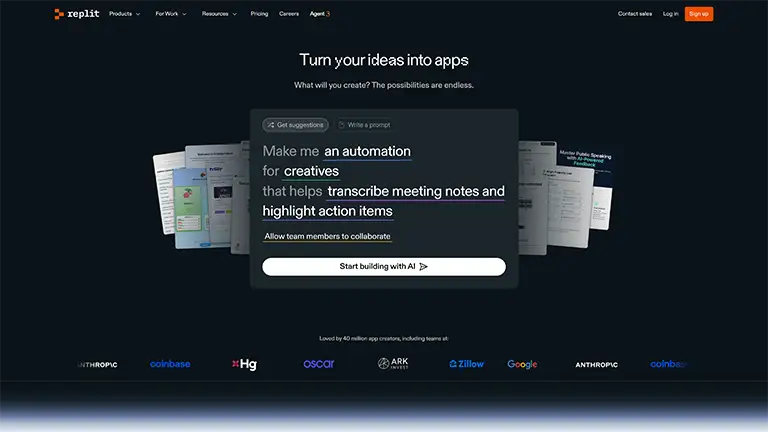
Why beginners love it: No local setup. Type an idea and the Agent scaffolds an app you can run and share instantly.
Starter setup
-
- Create a Replit account → choose a template (HTML/CSS/JS) → open AI panel.
-
- Ask the Agent to add features (forms, API calls) and read the diffs it makes.
-
- Click Deploy to share a live URL.
Learn more
-
- Agent & AI overview – https://replit.com/ai
-
- Pricing & free tier – https://replit.com/pricing
(get $10 free credits when signing up with this link)
- Pricing & free tier – https://replit.com/pricing
3) Cursor (AI‑First Code Editor)

Why beginners love it: Cursor’s Agent can make multi‑file edits, and the free Hobby tier is enough to learn prompting inside a familiar VS Code‑style UI.
Starter setup
-
- Install Cursor (Hobby) → open a starter project.
-
- Use Agent to “add form validation”, “create a React component with tests”, etc.
-
- Read the patch preview before applying changes.
Learn more
-
- Pricing & plan details – https://cursor.com/pricing
-
- Pro usage credits explained – https://cursor.com/blog/june-2025-pricing
4) Frontend Mentor (Hands‑On Project Practice)
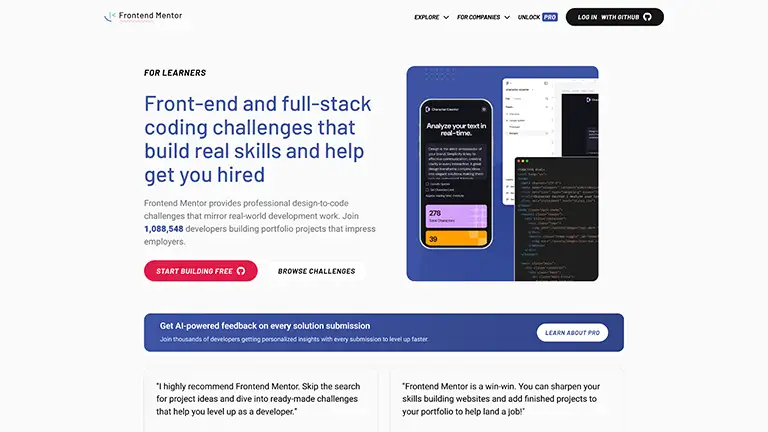
Why beginners love it: Realistic UI challenges with designs, assets, and community feedback—perfect for building a portfolio.
Starter setup
-
- Pick a Newbie or Junior challenge → build with your stack.
-
- Post your solution to get code reviews from the community.
Learn more
-
- Platform overview – https://www.frontendmentor.io/
-
- Challenges & learning paths – https://www.frontendmentor.io/challenges and https://www.frontendmentor.io/learning-paths
5) Vercel (Free Hobby Deploys)
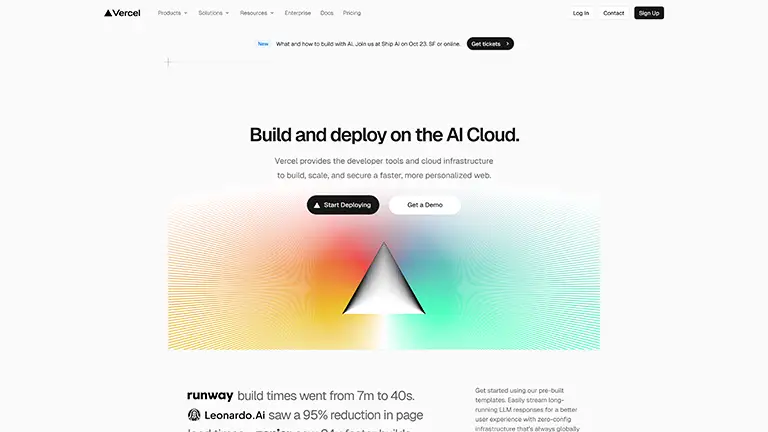
Why beginners love it: Connect your GitHub repo and deploy automatically on every push; perfect for demos and portfolios.
Starter setup
-
- Push your project to GitHub → Import to Vercel → Deploy.
-
- Add a custom domain and preview branches for PRs.
Learn more
-
- Hobby plan – https://vercel.com/docs/plans/hobby
-
- Pricing overview – https://vercel.com/docs/pricing
Alternative: Netlify’s Free plan is also beginner‑friendly and includes generous deploys.
-
- Netlify Free intro – https://www.netlify.com/blog/introducing-netlify-free-plan/
-
- Netlify pricing – https://www.netlify.com/pricing/
Bonus: Proof that AI is mainstream (Motivation)
-
- 84% of developers use or plan to use AI tools in 2026 (Stack Overflow Developer Survey). Start practicing with AI now to build the right habits.
-
- Survey highlights – https://survey.stackoverflow.co/2025/ai
-
- 84% of developers use or plan to use AI tools in 2026 (Stack Overflow Developer Survey). Start practicing with AI now to build the right habits.
Beginner Setup Checklist (One Page)
Where this fits: Placed here, immediately before Conclusion, so beginners can copy/paste and launch a complete learning environment in under an hour.
0) Accounts & Installs
-
- Create accounts: GitHub, Vercel, (optional) Replit.
-
- Install: Node.js LTS, Git, Cursor (or VS Code), a Chromium‑based browser.
-
- Enable in editor: GitHub Copilot (or Cursor Agent), ESLint, Prettier, Tailwind CSS IntelliSense.
1) New Project (React + Vite + TypeScript)
# pick pnpm if you have it; otherwise use npm
npm create vite@latest my-app -- --template react-ts
cd my-app
npm install
npm run devOpen http://localhost:5173 to confirm it runs.
2) Initialize Git & Push to GitHub
git init
git add -A
git commit -m "chore: init app"
# if you have GitHub CLI installed
gh repo create my-app --public --source=. --remote=origin --push
# otherwise create a repo on GitHub, then:
# git remote add origin https://github.com/<you>/my-app.git
# git push -u origin main3) Quality Guardrails (Lint, Format, Strict TS)
npm i -D typescript eslint @typescript-eslint/parser @typescript-eslint/eslint-plugin \
prettier eslint-config-prettier eslint-plugin-react eslint-plugin-react-hooks eslint-plugin-importAdd to package.json:
"scripts": {
"lint": "eslint \"src/**/*.{ts,tsx}\"",
"format": "prettier -w ."
}Set tsconfig.json → "strict": true. (Optional) Pre-commit checks:
npm i -D husky lint-staged
npx husky init
echo 'npx lint-staged' > .husky/pre-commitAdd to package.json:
"lint-staged": {"src/**/*.{ts,tsx,css,md}": ["eslint --fix","prettier -w"]}4) Unit Testing (Vitest + RTL)
npm i -D vitest @testing-library/react @testing-library/user-event jsdom @types/jsdomAdd to package.json:
"scripts": {"test": "vitest"}Create src/App.test.tsx with a simple render test and run npm test.
5) E2E (Optional, Playwright)
npm create playwright@latest
npm run test:e2e6) Security Basics
-
- Turn on Dependabot (GitHub → Settings → Security).
-
- (Optional) Install Snyk CLI and run
snyk testlocally/CI.
- (Optional) Install Snyk CLI and run
7) One‑Click Deploy (Vercel)
-
- In Vercel, Import Project → select your GitHub repo → Framework: Vite → Deploy.
-
- (Optional)
npm i -g vercel && vercelfor CLI deploys.
- (Optional)
8) Beginner AI Workflow (Daily Habits)
-
- Ask Copilot/Cursor: “Explain this file”, “Suggest tests for component X”, “Refactor to custom hook”.
-
- Use diff/patch previews before accepting changes; run tests after every AI edit.
9) Portfolio Hygiene
-
- Write a concise README.md (project goal, stack, scripts, live link, screenshots).
-
- Add a /docs/changelog.md and update per commit; link your Vercel preview.
Conclusion
AI won’t replace developers—it amplifies them. Winning teams pair agentic tools with disciplined verification and thoughtful integration. Architect your AI toolchain around your stack, risk profile, and business goals, and you’ll ship faster with higher quality—and less burnout.
FAQ
Install Copilot or Cursor, enable tests and Snyk in CI, and practice structured prompts with clear acceptance criteria.
Define non‑negotiables (tests, a11y, perf budgets). Reject code that doesn’t meet them—no exceptions.
Copilot for GitHub‑centric teams; Cursor for power users; Tabnine for strict privacy; Amazon Q for AWS‑heavy workloads.
No. Use it to automate regressions and generate tests, but keep human exploratory testing.
Add prompt hardening, input validation, rate limiting, content filters, and AI red‑team exercises; scan dependencies and containers.
Track cycle time, PR throughput, escaped defects, performance metrics, and developer satisfaction.
Increasingly, yes—but you’re accountable for correctness, security, and UX. Keep humans in the loop.

